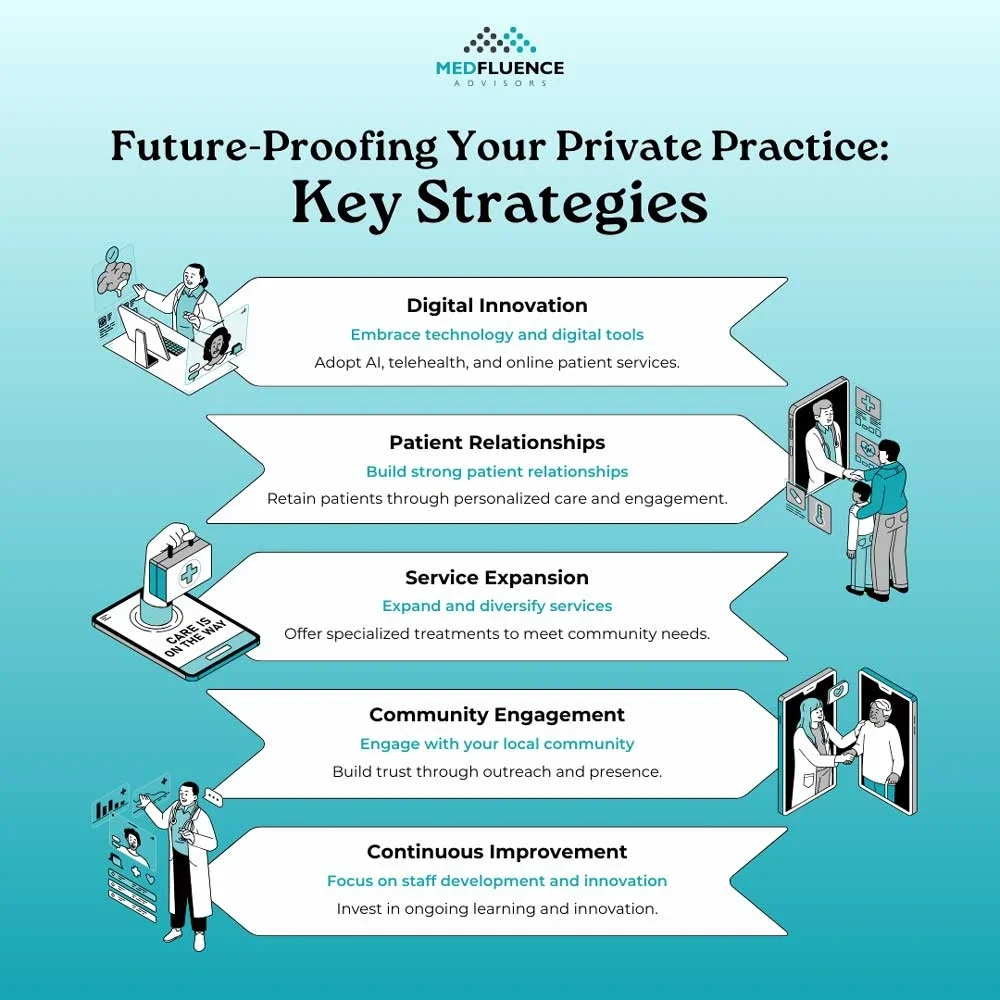The State of Private Practice as 2024 Comes to a Close

The landscape of private practice in 2024 is marked by significant transformation, driven by evolving patient expectations, technological advancements, and increasing competition from larger healthcare systems. As small to midsize practices navigate these changes, they face a myriad of challenges that threaten their ability to attract and retain patients. Understanding the current state of private practice is crucial for practitioners seeking to thrive in this dynamic environment.
In recent years, the healthcare sector has experienced a seismic shift towards patient-centered care, emphasizing the importance of enhancing patient experience. This shift has been compounded by the aftermath of the COVID-19 pandemic, which not only altered how care is delivered but also reshaped patient behavior and expectations.
Patients are now more informed and engaged in their healthcare decisions, demanding higher levels of service and communication from their providers. As a result, private practices must adapt their strategies to meet these new demands while also addressing the economic pressures and regulatory complexities that accompany them.
The purpose of this white paper is to provide a comprehensive analysis of the state of private practice in 2024. It will explore the historical context that has shaped current challenges, examine innovative solutions that practices can implement to enhance patient experience, and outline effective marketing strategies for attracting new patients.
By delving into these topics, we aim to equip private practice owners and healthcare professionals with the insights needed to navigate the evolving landscape effectively. Ultimately, our goal is to foster a deeper understanding of how practices can connect with patients suffering from undiagnosed or latent diseases, ensuring they receive the innovative care they need while promoting sustainable growth for private practices.
Evolution of Private Practice
The history of private practice in healthcare has undergone significant transformations, particularly over the last few decades. Initially, private practices were the cornerstone of healthcare delivery, characterized by small, independent operations where physicians built personal relationships with their patients. This model allowed for a high degree of autonomy and the ability to tailor care to individual patient needs. However, as healthcare systems evolved, so too did the landscape in which these practices operated.
Over the past decade, several key changes have reshaped private practice. The rise of large healthcare systems and hospital consolidations has created an environment where independent practices face increasing competition. These larger entities often have more resources for marketing, technology, and patient outreach, making it challenging for smaller practices to attract new patients. Additionally, the shift towards value-based care has forced practices to adapt their business models to focus on patient outcomes rather than volume of services provided. This evolution requires private practices to implement innovative strategies to remain viable and competitive.
Furthermore, regulatory changes have added complexity to practice operations. The introduction of electronic health records (EHR) mandates and compliance requirements has placed additional burdens on small practices that may lack the administrative support needed to navigate these challenges effectively. As a result, many private practices have had to rethink their operational strategies and invest in new technologies to enhance efficiency and patient care.
Impact of COVID-19
The COVID-19 pandemic has had a profound impact on patient behavior and practice operations, accelerating trends that were already underway in the healthcare sector. One of the most significant effects has been a shift in how patients engage with healthcare services. Fear of exposure to the virus led many patients to delay or avoid in-person visits, prompting a reevaluation of how care is delivered.
As a response to these challenges, private practices rapidly transitioned to telehealth and digital services. Telehealth emerged as a vital tool for maintaining continuity of care while adhering to social distancing guidelines. This shift not only allowed practices to continue serving their patients but also introduced new opportunities for engagement. Patients who may have previously been reluctant to use telehealth found it a convenient option for consultations, follow-ups, and even some diagnostic services.
The transition to digital services also included the implementation of patient portals and online scheduling systems, which facilitated better communication between providers and patients. These tools empowered patients by giving them greater control over their healthcare experience, allowing them to access information and manage appointments from the comfort of their homes.
The historical context of private practice reveals a landscape that has been shaped by evolving patient needs, competitive pressures from larger healthcare systems, and significant disruptions caused by the COVID-19 pandemic. Understanding these dynamics is crucial for private practices aiming to adapt and thrive in 2024 and beyond.
Current Challenges Facing Private Practices
Economic Pressures
Private practices in 2024 are grappling with significant economic pressures that threaten their sustainability and growth.
- Rising costs and reimbursement issues are at the forefront of these challenges. Overhead expenses, including rent, utilities, staff salaries, and medical supplies, have continued to escalate, often outpacing revenue growth.
- Additionally, reimbursement rates from insurance companies have stagnated or decreased, placing further strain on the financial viability of small to mid-size practices. This situation necessitates a careful balancing act between maintaining quality patient care and managing operational costs.
- Moreover, private practices face intense competition from larger healthcare systems that have greater resources and marketing power. These larger entities can invest heavily in advertising and patient acquisition strategies, making it increasingly difficult for independent practices to attract new patients.
As a result, many private practitioners find themselves competing not only for patients but also for skilled personnel who are often drawn to the stability and benefits offered by larger organizations.
Marketing and Patient Acquisition
The landscape of marketing and patient acquisition has shifted dramatically in the post-pandemic era. Shifts in marketing strategies have become necessary as traditional methods, such as print advertising and local outreach, have proven less effective in reaching potential patients. The rise of digital marketing has created both opportunities and challenges for private practices. While online presence is essential for visibility, many smaller practices often lack the expertise or budget to effectively engage in digital marketing strategies such as search engine optimization (SEO), social media marketing , and content creation.
This shift has led to challenges in attracting new patients in an increasingly crowded market. Patients now have access to a wealth of information online, making them more discerning when choosing healthcare providers. Independent practices must find innovative ways to differentiate themselves and communicate their unique value propositions to potential patients. Building a strong online reputation through patient reviews and testimonials has become crucial for establishing trust and credibility in a competitive environment.
Regulatory Changes
The regulatory landscape for healthcare has evolved significantly, introducing new regulations affecting private practices. Compliance with these regulations can be daunting for small practices that may not have dedicated legal or administrative resources. Changes in billing codes, insurance requirements, and patient privacy laws necessitate continual education and adaptation by practice owners and staff.
These compliance challenges can divert attention away from patient care and operational efficiency, leading to frustration among healthcare providers. For instance, navigating the complexities of electronic health record (EHR) systems not only requires financial investment but also ongoing training for staff to ensure proper usage. The implications of non-compliance can be severe, including financial penalties and damage to the practice’s reputation.
Private practices in 2024 face a multifaceted array of challenges stemming from economic pressures, evolving marketing dynamics, and stringent regulatory requirements. Addressing these issues is vital for ensuring the long-term viability of independent practices as they strive to provide high-quality care while adapting to an ever-changing healthcare landscape.
Innovations in Private Practice
Technological Advancements
To thrive amidst these challenges, private practices are increasingly embracing technological advancements that enhance operational efficiency and improve patient care delivery. The adoption of telehealth has emerged as a pivotal innovation that allows providers to offer remote consultations, thereby expanding access to care for patients who may face barriers to in-person visits. This shift not only meets patient demand for convenience but also helps practices maintain continuity of care during disruptions such as pandemics or natural disasters.
In addition to telehealth services, the use of electronic health records (EHR) and practice management software has become essential for streamlining administrative processes. These technologies facilitate better documentation, scheduling, billing, and communication within the practice. By automating routine tasks, healthcare providers can focus more on patient interactions rather than administrative burdens, ultimately enhancing the overall patient experience.
Innovative Treatment Options
The landscape of healthcare is also witnessing an influx of innovative treatment options that cater to emerging patient needs. Practices are exploring new modalities such as regenerative medicine, minimally invasive procedures, and personalized medicine approaches that leverage genetic insights for tailored treatment plans. These innovations not only improve clinical outcomes but also position private practices as leaders in providing cutting-edge care.
Innovations in technology and treatment options present private practices with opportunities to differentiate themselves in a competitive market while improving patient outcomes. By embracing these advancements, independent practitioners can navigate current challenges more effectively and position themselves for future success in an evolving healthcare landscape.
Marketing Strategies for Success

Building a Strong Online Presence
Establishing a strong online presence is crucial for private practices seeking to attract and retain patients. A professional website serves as the cornerstone of this online presence, providing essential information about services, staff, and contact details. It is imperative that the website is user-friendly, mobile-responsive, and optimized for search engines through effective search engine optimization (SEO) strategies. By utilizing relevant keywords, creating quality content, and ensuring fast loading times, practices can improve their visibility on search engines, making it easier for potential patients to find them.
Additionally, leveraging social media platforms such as Facebook, Instagram, and LinkedIn can significantly enhance patient engagement. These platforms allow practices to share valuable health information, promote services, and interact with patients in real-time. Regular updates and engaging content can help build a community around the practice, fostering loyalty and encouraging patients to share their positive experiences with others.
Content Marketing and Education
Content marketing plays a vital role in attracting new patients by providing valuable information that addresses their concerns and interests. Creating informative blog posts, articles, and videos can position a practice as a trusted authority in its field. This educational content should focus on common health issues, treatment options, and preventive care tips that resonate with the target audience.
Moreover, organizing educational workshops or community events can further enhance visibility and establish the practice as a community resource. These workshops provide opportunities for direct interaction with potential patients, allowing them to ask questions and gain insights into their health concerns. By actively participating in community events and health fairs, practices can strengthen their ties to the local community while promoting their services.
Referral Networks and Partnerships
Building strong referral networks is an essential strategy for private practices looking to expand their patient base. Establishing relationships with other healthcare providers—such as specialists, hospitals, and complementary service providers—can lead to mutual referrals. Practices should actively engage in networking opportunities and professional organizations to foster these relationships.
Collaborations with other healthcare providers can also enhance service offerings. For example, partnering with physical therapists or nutritionists allows practices to provide comprehensive care solutions for patients. This collaborative approach not only improves patient outcomes but also increases the likelihood of referrals from partner organizations.
The Future Outlook for Private Practices
Trends to Watch in the Coming Years
As we look ahead to the future of private practice, several trends are emerging that will shape patient care models and service delivery. One significant trend is the increasing emphasis on patient-centered care, where practices prioritize individual patient needs and preferences in treatment plans. This shift is expected to foster stronger patient-provider relationships and improve overall satisfaction.
The role of technology will continue to expand in shaping future practices. Innovations such as artificial intelligence (AI) in diagnostics, advanced telehealth platforms, and wearable health monitoring devices are poised to revolutionize how care is delivered. These technologies not only enhance efficiency but also empower patients by providing them with more control over their health management.
Strategies for Resilience and Growth
To navigate ongoing changes successfully, private practices must adopt strategies for resilience and growth. One recommendation is to embrace continuous learning by staying informed about industry trends, regulatory changes, and emerging technologies. This commitment to education will enable practices to adapt quickly to new challenges while remaining competitive.
Additionally, emphasizing flexibility in operations will be crucial for responding effectively to market shifts. Practices should be open to experimenting with new service delivery models—such as hybrid care options that combine in-person visits with telehealth services—to meet evolving patient preferences.
By implementing robust marketing strategies focused on building an online presence, creating valuable content, fostering referral networks, and adapting to future trends through resilience and growth strategies, private practices can position themselves for success in an increasingly complex healthcare landscape.
Adapt, Innovate, Thrive: Embrace the Future of Private Practice Today!

The state of private practice in 2024 is defined by rapid change and evolving patient expectations, creating both challenges and opportunities for independent healthcare providers. To remain viable and competitive, private practices must adopt innovative strategies, embrace technology, and focus on patient-centered care. By leveraging digital tools, streamlining operations, and fostering strong community ties, these practices can not only survive but thrive in the dynamic healthcare landscape of the future. The ability to adapt and innovate will determine long-term success and sustainability for private practitioners moving forward.


